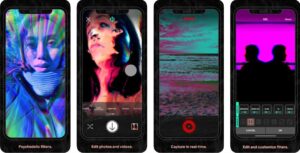Photo editing software has become increasingly popular in recent years. Not only does it allow users to make quick and easy adjustments to their photos, but it also opens up a world of creative possibilities. Trippy photo editors are a unique type of photo editing software that can create a variety of psychedelic or surreal effects. With the right tools and techniques, users can create stunning visuals that go beyond the realm of traditional photography.
Trippy photo editors can be used to apply a wide range of psychedelic effects to photos. Effects range from color shifts and distortions to kaleidoscopic patterns and kaleidoscopic animations. These effects can be used to create visuals that range from the whimsical to the surreal. They can also be applied to photos to give them an eerie or dreamlike quality.
One of the most popular effects created with trippy photo editors is an animation known as a “warp.” This effect warps the photo in a way that looks like it is moving in a wave-like pattern. This effect can be used to create a sense of movement and energy in a photo or to create a dreamlike atmosphere.
Another popular effect is a “glitch.” This effect creates a visual distortion that can be used to create a sense of chaos and confusion. It can be used to make a photo look more surreal or to give it a sci-fi or futuristic feel.
The possibilities of trippy photo editors are limitless. By combining various effects, users can create visuals that are truly unique and captivating. With the right tools and techniques, users can create amazing visuals that go beyond the realm of traditional photography.
Tips and Tricks for Creating Stunning Trippy Effects with Photo Editors
1. Use Filter Effects: Photo editors have a variety of filter effects that can be used to create stunning trippy effects. This includes utilizing color filters, contrast filters, blur filters, and more. Experiment with different combinations to achieve the desired effect.
2. Utilize Warping Tools: Warping tools are a great way to create trippy effects. These tools can be used to distort parts of the photo, add swirls, and more.
3. Play with Contrast and Brightness: Adjusting the contrast and brightness of a photo can dramatically change the look and feel of an image. This can be used to create a trippy effect.
4. Use Textures: Adding various textures to a photo can help create a unique, trippy effect. Experiment with different textures to see which one works best for your image.
5. Experiment with Color: Utilizing different colors can help create a trippy effect. Try different combinations of colors to see which best suits the image.
6. Layer Images: This can help create a more complex, trippy effect. Layer multiple images with different effects to achieve the desired result.
7. Use HDR Effects: High Dynamic Range (HDR) effects can also be used to create a trippy effect. Experiment with different HDR settings to see which one works best.
8. Try Motion Blur: Adding motion blur to an image can help create a sense of movement, making the photo look more trippy.
Comparing the Features of Popular Trippy Photo Editors and Their Unique Capabilities
When it comes to editing photos, there are many options available. One of the most popular types of photo editors are those that are designed for creating trippy photos. Trippy photo editors allow users to create unique and eye-catching images with a surreal and psychedelic feel. The following article will compare the features of some of the most popular trippy photo editors and highlight their unique capabilities.
The first trippy photo editor that we will look at is Photoshop. Photoshop is one of the most widely used photo editors and has a variety of tools and functions to help you create a trippy image. Photoshop can be used to apply filters and effects to an image, as well as to create layered images by combining different elements. Photoshop also has a wide selection of brushes, textures, and other features that can be used to create a unique trippy look.
Another popular trippy photo editor is GIMP. GIMP is a free and open source image editor that has many of the same features as Photoshop. GIMP includes tools for manipulating images and creating layers, as well as a wide selection of filters and effects. GIMP also has a variety of unique tools for creating trippy images, such as the ability to distort an image or add a kaleidoscope-like effect.
Finally, we will look at Pixlr. Pixlr is a free online photo editor that has a wide selection of tools and filters. Pixlr also has a variety of special trippy effects that can be used to create an interesting look. In addition to the standard filters and effects, Pixlr also has a feature called “Dreamy” that can be used to create a surreal and dreamlike look.
Overall, each of these popular trippy photo editors has its own unique capabilities. While Photoshop and GIMP both offer a wide range of features, Pixlr has the advantage of being free and online. Additionally, Pixlr has a variety of special effects and tools for creating a unique trippy look. Regardless of the editor you choose, you can be sure that you will be able to create unique and eye-catching images.
